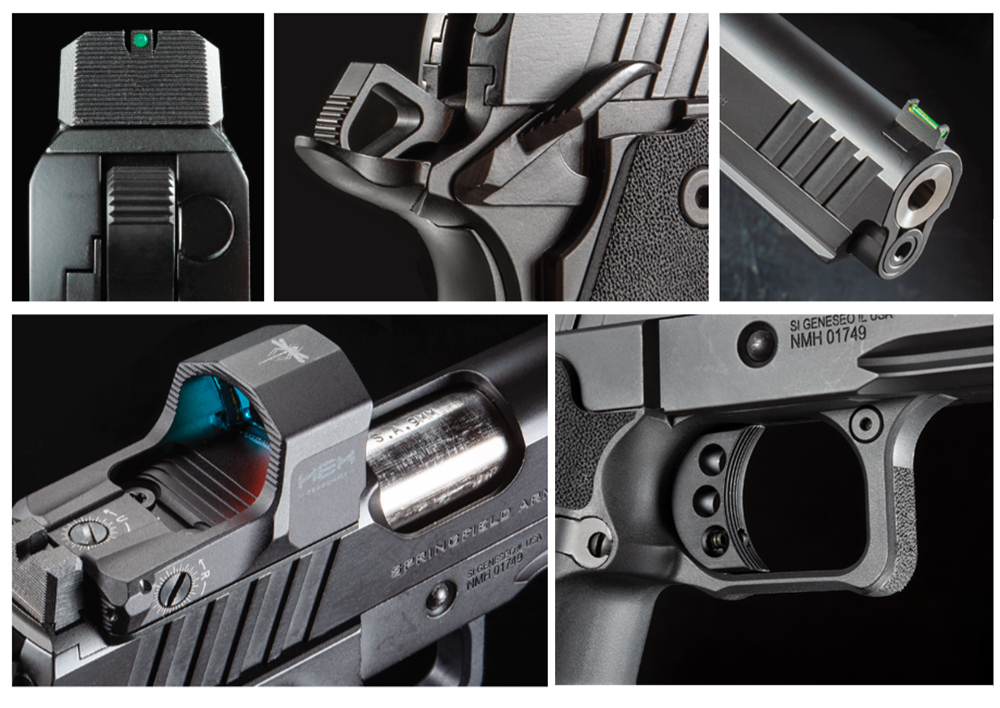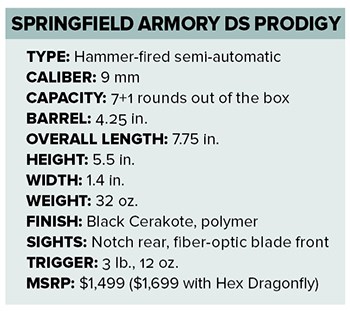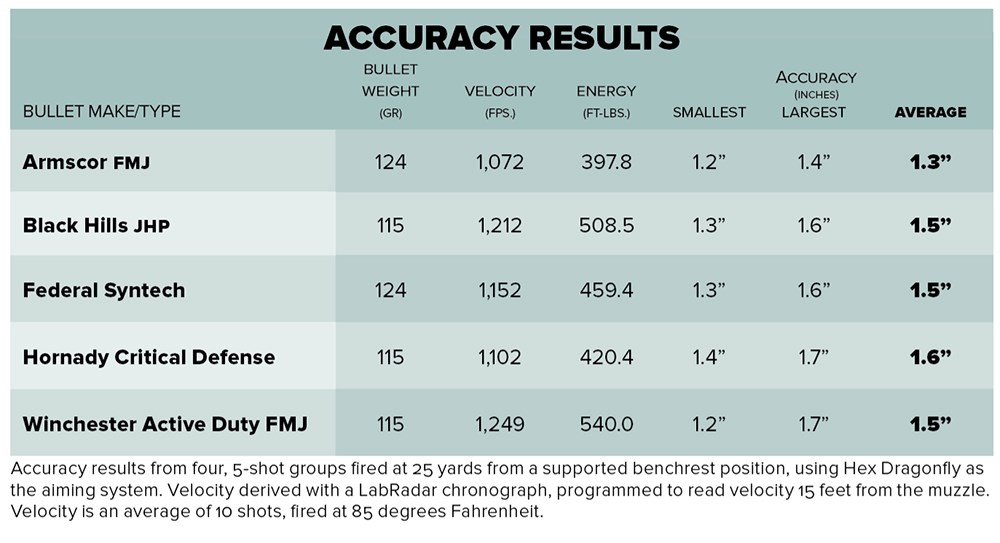Gun Review: Springfield Armory DS Prodigy
The half-steel, half-polymer Model 1911 pistol design, brought to the market by the late Chip McCormick, swept through the competition circuit like a tropical storm back in the early 1990s. The original design reflected the times. It was built to be a .45 ACP if the end-user so desired (the first ones were only frames, meant to be built on), but was also suitable for the .38 Super.
Today, the .45 is in second place among users, the Super is found only on competition ranges and the 9 mm is king. So, while it was surprising when Springfield Armory came out with the DS Prodigy, it was not surprising that it was chambered in 9 mm.
The DS Prodigy is a 1911 platform, and parts will interchange within manufacturing tolerances. The frame, which is the serialized part, is the horizontal steel segment consisting of the slide rails, the recoil-spring dust cover and the fire-control parts in the pin area. The slide and barrel, the recoil-spring assembly, and the hammer, the sear and the thumb and grip safeties are all assembled into the steel section. Attached to the steel part of the frame assembly is the polymer housing that holds the magazine and the magazine release button—it also guides the trigger in its movement.
- Buy All-American!
- Bring health and vitality back to your body with these non-transdermal patches
- Get your Vitamin B17 & Get 10% Off With Promo Code TIM
- How To Protect Yourself From 5G, EMF & RF Radiation - Use promo code TIM to save $$$
- The Very Best All-American Made Supplements On The Maret
- Grab This Bucket Of Heirloom Seeds & Save with Promo Code TIM
- Here’s A Way You Can Stockpile Food For The Future
- Stockpile Your Ammo & Save $15 On Your First Order
- Preparing Also Means Detoxifying – Here’s One Simple Way To Detoxify
- The Very Best Chlorine Dioxide
- All-American, US Prime, High Choice Grass-Fed Beef with NO mRNA, hormones or antibiotics... ever!
While still honoring its legacy, Springfield has brought the DS Prodigy fully into the 21st century. The slide is built to accept a red-dot optic, and while the removable plate takes the rear sight with it, the replacement adapter plate has its own rear sight blade, so you keep the iron sights and you don’t lose your zero when changing from one to the other.

Springfield Armory also makes an excellent line of red-dot optics, and you can have your DS Prodigy with just irons, for later optics installation or with a Hex optic right out of the box. The standard front blade is fiber optic, while the rear blades are black, steel and serrated.
The barrel is a bushing-less bull barrel, with an integral feed ramp for full case support, and this means that the DS Prodigy has no problem with 9 mm +P ammunition. The lack of a bushing means the recoil spring assembly uses a reverse plug design, which is why Springfield Armory includes a small disassembly pin in the box. (Competition shooters long ago learned to also keep a paper clip in their gun bag, as a handy tool for disassembly.)
The dust cover has an accessory rail for a light or laser, and the dust cover width is carried back in the steel frame, so there is a bit of extra weight to offset the lightness of the polymer grip housing.
At the rear is an ambidextrous thumb safety and the Springfield scalloped grip safety, with a speed bump at the bottom. The contours of the tang are machined to provide protection for your hand from the hammer, while keeping the bulk of the tang to the smallest-possible profile.
Inside, there are the expected and excellent fire-control parts, with a loop hammer, a lightened trigger and a clean and crisp trigger pull.
The grip module is not the same profile as the 1990-era originals. Back then, grips were expected to look like grips, so the contour was blocky, checkered and square-ish. Also, shooters back then were still deeply suspicious of polymer, so it was made with walls thicker than needed. It wasn’t long before competition shooters were carving on the polymer with power tools to make the shape more ergonomic. Springfield jumped past those decades of development, so the DS Prodigy has a reduced-size contour, complete with a stippled non-slip surface treatment. The bottom of the trigger guard has been relieved and contoured to allow your hand as high a grip as possible. The bottom of the frame, at the mag well, has been beveled in the inside, and the front lip extended, to aid in fast reloads.
 One of the irritations of the original design was that the magazines were almost an afterthought. Yes, they had a lot of capacity, but they often needed tuning. It was common for them to either lock open with one round left in the magazine or not lock open at all. It took attention to make them 100%. Springfield knew that. They went to DuraMag for their magazines, so those problems have been solved. The standard DS Prodigy magazine holds 17 rounds, and each pistol comes with one of those and a 20-round magazine as well. Springfield has additional magazines for sale, including an extended 26-round version.
One of the irritations of the original design was that the magazines were almost an afterthought. Yes, they had a lot of capacity, but they often needed tuning. It was common for them to either lock open with one round left in the magazine or not lock open at all. It took attention to make them 100%. Springfield knew that. They went to DuraMag for their magazines, so those problems have been solved. The standard DS Prodigy magazine holds 17 rounds, and each pistol comes with one of those and a 20-round magazine as well. Springfield has additional magazines for sale, including an extended 26-round version.
The DS Prodigy can be had in two barrel/slide lengths: a full five-inch Government model length, and a shorter, Commander length. The Commander length is the one used in this testing. While the three-quarters-of-an-inch-shorter barrel will no doubt take a few feet-per-second off your muzzle velocity, it also makes it an easier daily carry. The longer barrel is more likely to bump on the seats of chairs, or to show below the edge of a garment, which is why those who carry often opt for shorter barrels. The larger grip is a bit bulkier than a single-stack magazine, and the weight of the DS Prodigy, plus a loaded magazine, can top 40 ounces. But, a proper holster (and you should always be carrying in a proper holster) provides comfort and security.
I function-tested the 4.25-inch DS Prodigy with both the iron sights and a Springfield Hex Dragonfly and the gun’s accuracy with the Hex Dragonfly. Red-dot optics make accurate shooting a lot easier, and they are rapidly becoming a default everyday-carry item on pistols, so testing a carry-suitable pistol with an optic is reasonable.
During testing, all rounds ejected and fed, the slide locked open after the last round was fired, and each magazine fell free on its own weight. As a daily-carry choice, the DS Prodigy provides the same capacity as most striker-fired polymers pistols; however, it adds the much-better trigger of the 1911, and a better trigger almost always means more-accurate shooting. The DS Prodigy in the Commander length is also suitable as a competition pistol, so one would have the added benefit of practicing and competing with the same pistol used in daily carry.

The steel and polymer parts, while clearly bolted together, are not meant to come apart, so cleaning is as normal.
Perhaps the best part is the price. Springfield Armory, which makes this pistol here in the USA, has priced it a thousand dollars less than pistols with similar specifications.
Article by PATRICK SWEENEY
Don't forget to like us on Facebook and follow us on Twitter.














